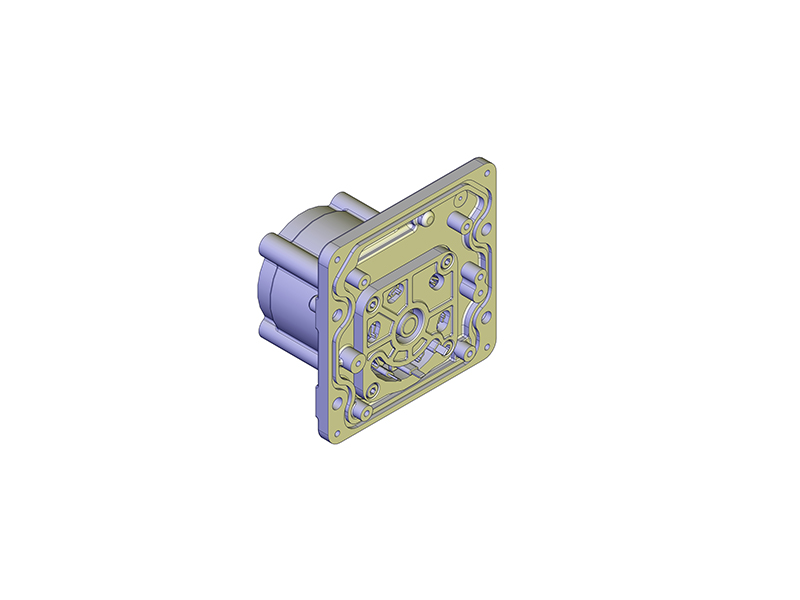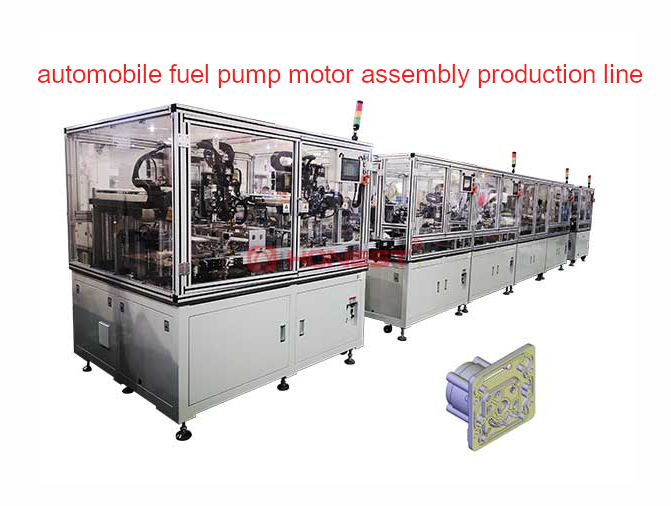The fuel pump motor usually refers to the electric fuel pump component in the automobile fuel system. It is a sophisticated mechatronic device responsible for delivering fuel from the fuel tank to the engine’s fuel supply system. The process is critical to proper engine operation as the fuel pump motor ensures that fuel is delivered to the engine at the proper pressure and flow.
1. Structure of the Fuel Pump Motor
Pump Housing: It is the outer shell of the fuel pump motor, typically made of metal or engineering plastics, which provides structural support and a sealed environment for the internal components.
Impeller: It is a key component inside the pump housing, usually made of lightweight materials and designed with multiple blades.
DC Motor: It is the power source of the fuel pump motor, converting electrical energy into mechanical energy to drive the rotation of the impeller.
Permanent Magnet: It is fixed on the stator, generating a stable magnetic field that interacts with the rotor to produce torque.
Rotor: It is the rotating part of the motor, usually composed of the armature, which contains coils that produce a magnetic field when electrified.
Commutator: It is part of the rotor, it changes the direction of the current through contact with brushes and the armature coils as the rotor rotates, maintaining the continuous rotation of the motor.
Carbon Brushes: Mounted on the brush holder, they transfer current from the external circuit of the motor to the armature coils of the rotor.
Brush Holder: It secures the carbon brushes, ensuring stable electrical contact between the brushes and the commutator.
Sealing System: Various seals are installed on the end cover to ensure that fuel can only flow from the pump housing to the engine, preventing fuel backflow.
Check Valve: Installed on the end cover to ensure unidirectional fuel flow from the pump housing to the engine, preventing fuel backflow.
Pressure Relief Valve: It is used to control the pressure in the fuel system, preventing damage to the system due to excessive pressure.
End Cap: It seals one end of the pump housing, with the motor’s terminal connectors, check valve, and pressure relief valve installed on it.

2. Working Principle of the Fuel Pump Motor
The fuel pump motor is a core component in the automotive fuel system, responsible for transporting fuel from the fuel tank to the engine and ensuring stable engine operation.
When the ignition switch of the vehicle is activated, electric current flows from the battery to the DC motor. The interaction between the permanent magnet and the armature coil generates torque, which drives the impeller to rotate. The design of the impeller creates a low-pressure area at the intake to draw in fuel and a high-pressure area at the outlet to deliver fuel to the engine. The check valve ensures unidirectional fuel flow, while the pressure relief valve releases pressure when system pressure is too high, protecting the system’s safety.
In terms of structural composition, the pump housing provides structural support and a sealed environment. The impeller rotates inside the pump housing to transport fuel. The DC motor converts electrical energy into mechanical energy. The commutator and carbon brush system maintain the continuous rotation of the motor, and the sealing system prevents fuel leakage and the intrusion of contaminants.
3. Advantages of the Fuel Pump Motor
High Efficiency: The fuel pump motor is designed to provide efficient fuel delivery at a low energy cost, thereby improving the fuel efficiency of the entire vehicle.
Compact Design: Designed to fit within the limited space of the engine compartment, reducing the vehicle’s overall weight and improving space utilization.
Low Noise Operation: Employs advanced noise reduction technologies for quiet operation and enhanced driving comfort.
High Reliability and Durability: Made with High-quality materials and precise manufacturing processes for long-term stable operation.
Easy Maintenance: Many models are designed for easy maintenance with simple part replacement and troubleshooting.
Integrated Control: Some fuel pump motors come equipped with an integrated electronic control unit that can communicate with the engine control unit (ECU) to achieve more accurate fuel supply.
4. Disadvantage of the Fuel Pump Motor
Cost Concerns: High-quality fuel pump motors can be expensive, especially with advanced technologies and materials.
Technical Complexity: As functionalities increase, the manufacturing and maintenance of fuel pump motors may become more complex.
Electromagnetic Interference: Fuel pump motors may generate electromagnetic interference during operation, necessitating appropriate shielding measures.
5. Precautions
Regular Inspection: Regularly inspecting the fuel pump motor is essential to ensure its proper operation, detect and resolve issues promptly.
Fuel Quality: Use high-quality fuel to prevent impurities in low-quality fuel from damaging the fuel pump motor.
Avoid Dry Running: Ensure sufficient fuel in the tank to prevent motor burnout.
Maintenance Records: Keep detailed maintenance records, including the times of inspections, repairs, and part replacements, to facilitate tracking equipment status and predicting.
Professional Training: Ensure maintenance personnel receive proper training to understand the working principles and maintenance requirements of the fuel pump motor.
Follow Operating Procedures: Strictly adhere to the manufacturer’s operating procedures and safety guidelines when operating and maintaining the fuel pump motor.
Environmental Factors: Consider the impact of environmental factors on the performance of the fuel pump motor, such as temperature and humidity, and take corresponding measures.

6. Functions of the Fuel Pump Motor
Fuel Delivery: The most fundamental function of the fuel pump motors is to transport fuel from the vehicle’s fuel tank to the engine’s fuel system. This is achieved by the motor driving the rotation of the impeller inside the pump, which generates a pressure difference to draw in and deliver fuel.
Pressure Maintenance: The fuel pump motor must be able to maintain stable fuel pressure under various operating conditions to ensure that the fuel injection system can precisely control the amount and timing of fuel injection, thereby optimizing engine performance and efficiency.
System Integration: Modern vehicle fuel pump motors are typically integrated with the engine control unit (ECU) to achieve smarter fuel management and engine performance optimization. The integration also facilitates fault diagnosis and preventive maintenance.
Safety Protection: The design of the fuel pump motor includes a pressure relief valve, which opens to release pressure when the pressure in the fuel system exceeds a preset safety value, protecting the fuel system from damage.
Self-Diagnostics and Monitoring: Fuel pump motors can be integrated with self-diagnostic functions that monitor their own operating status and provide real-time feedback through the onboard diagnostic system (OBD) for maintenance and troubleshooting.
Energy Saving and Environmental Protection: By optimizing design and using efficient materials, fuel pump motors can reduce energy consumption and heat generation, helping to improve the overall fuel efficiency of the vehicle and reduce environmental impact.
Adaptability: Fuel pump motors need to adapt to different driving conditions and types of fuel, ensuring stable operation in various temperature and pressure environments.
Durability and Reliability: When designing fuel pump motors, durability and reliability are considered for long-term use, with high-quality materials and precise manufacturing processes to ensure performance throughout the vehicle’s lifecycle.
Intelligence: As the automotive industry shifts towards intelligence and automation, fuel pump motors are also designed to work in conjunction with intelligent driving systems, supporting future autonomous driving technologies.
7. About HONEST Automation
HONEST Automation produced an automobile fuel pump motor assembly production line, which features a highly automated and guaranteed product quality line. It can produce one product in less than 75 seconds, with a yield rate that can reach up to 99%. HONEST Automation also provides customized services, ensuring that your specific requirements for efficiency, yield rate and o ther equipment specifications will be met.

If you need more details about our company and equipment, please contact us at your convenience.






